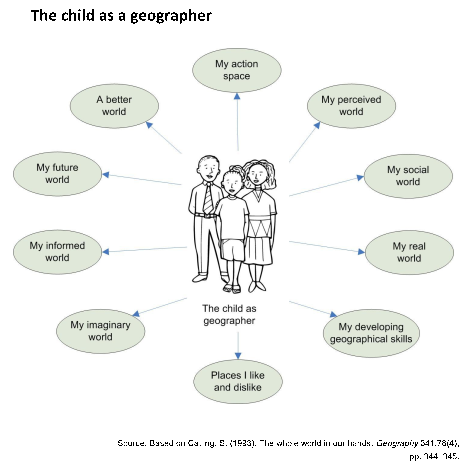Illustration 1: The child as geographer
Working with students
Most of us, or all of us, begin to learn Geography as soon as we can walk, if not sooner and we are studying it more or less all our lives.
Herbertson, A.J. cited in Catling, S. (1993). The whole world in our hands. Geography 78(4), pp. 344–345. Geography Association: Sheffield. © Geographical Association.
A primary school student's world is developed through interaction with people, places and the environment. Their geographical imagination is made up of real and imagined experiences and a fascination with the places they become aware of though their own experiences, the media with which they engage, and the stories they read or listen to. They are preoccupied with their perception and understanding of the world. Increasingly, they are immersed in the real world of people and environments.
From a very early age, they develop a sense of locational awareness – a recognition of their surroundings and a construction of the jigsaw pieces that begin to make sense of how the various elements of the environment relate to each other.
Gradually, they build up a more sophisticated knowledge of places to enrich the cognitive map of their world.
Classroom illustrations
In the Foundation (K) stage, students' action space is built from the spatial structures of their home, classroom or corner of the playground. In Year 2 their perceived world may contain stereotyped images of Asia and other places across the world. For example, they may be attracted by the 'exotic' and perhaps repelled by the 'strange'. Their social world, which is shaped by the lives of those they encounter and those they see living in other places, is enriched by the real world built up by knowledge of places 'behind the news'. View the diagram – The child as geographer – below.
As early as Foundation, young children realise that people enjoy special places, and the early years reinforce the notion that their imaginary worlds are created in both real and imaginary play. Young children develop their informed world by contact with various texts from the written and the aural through to a variety of electronic communication technologies. They are fascinated with living creatures (such as wild animals, birds and fish), with places that they visit, by their interactions with people from different places and by caring about the lives of children in distant places.
In the YouTube clip, Geography in Years 1 and 2 using the Australian Curriculum: Geography [https://www.youtube.com/watch?v=5pGpri67uK8&feature=youtu.be], a teacher reflects on how her students responded to learning geography for the first time.
Recommended reading
Later they will develop their moral geographies concerning what is right and wrong in the world, and may want to work for a better world in terms of improving their school surrounds and through supporting worthy causes in ever more distant places.
By Year 6 the students’ world of geographic competence will be well developed. This will include the skills by which they orient themselves in physical space and navigate from place to place (known as ‘wayfinding’), and how they use aerial photographs, models and maps.
Questions for discussion
- Why does the concept of place permeate the curriculum in the early years of schooling? To what extent is this concept central to the ideas expressed in The child as geographer?
- The curriculum in Year 5 has a significant focus on causation and the important concept, space. How do these two organising ideas help develop and deepen geographical thinking?
- To what extent does the Year 6 curriculum help extend students' thinking about their future world and their commitment for a better world?
- How does the extract My favourite geography lesson, and the YouTube clip Geography in Years 1 and 2 using the draft Australian Curriculum: Geography (duration 11.29) help to inform some different ways to extend students’ geographical imaginations?
- The starting point for any consideration of the Australian Curriculum: Geography in the primary school must lie in the 'child’s world’. Do you agree? Justify your opinion.
Questions for reflection
- To what extent does the Australian Curriculum: Geography recognise, explore and deepen each student’s cognitive map of their world?
- How can young children’s fascination and curiosity about places be fostered in primary school classrooms?
- How can geographical inquiry investigations enrich students’ informed world?
- What sort of content elaborations would enrich their multicultural and international understandings?
- How might the three cross-curriculum priorities better support the world that young students want to see in the future?
Resources
Catling, S. (1993). The whole world in our hands. Geography 78(4), pp. 344–345.
Catling, S. (2003). Curriculum contested: Primary geography and social justice. Geography 88(3), pp. 164–210.
Herbertson, A.J. cited in Catling, S. (1993). The whole world in our hands. Geography 78(4), pp. 344–345. Geography Association: Sheffield. © Geographical Association.
Martin, F. & Owens, P. (2005). Young children making sense of the world. In S. Scoffham (Ed.). Primary geography handbook. Sheffield: Geographical Association, pp. 63–73.
Palmer, J. & Birch, J. (2004). The young child in the geographical world. In J. Palmer & J. Birch. Geography in the early Years (2nd ed.). London: Routledge, pp. 1–27.
Scoffham, S. (2005). Young geographers. In S. Scoffham. (Ed.). Primary geography handbook. Sheffield: Geographical Association, pp. 15–23.
Spencer, C. & Blades, M. (1993). Children’s understanding of places: The world at hand. Geography 78(4), pp. 367–373.
